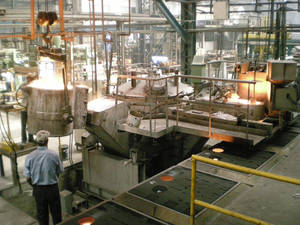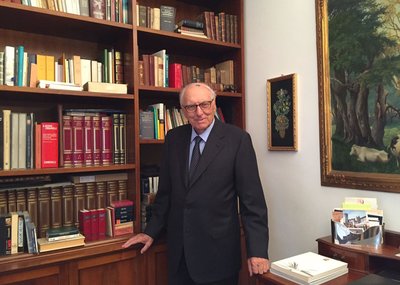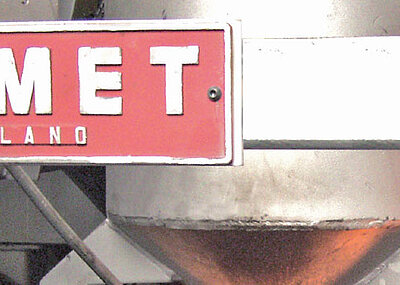Amtek India have signed a technical collaboration agreement with Teksid (FIAT GROUP) based
n Turin, Italy. Teksid is a world leader in the production of iron castings for the automotive industry
with operations spread out in Europe, North and South America and Asia.
Teksid Iron Foundries are a world leading manufacturer of grey and nodular iron castings, whose quality is continuously tuned with the ever more exacting demands of the world-wide automotive industry. Its main products are grey iron cylinder blocks for light vehicles, engine blocks and heads for trucks engine, exhaust manifolds, nodular iron crankshafts, camshafts, steering knuckles, suspension arms, and differential cases.
FOMET have been furnace suppliers to Teksid over many years, but before signing the agreement, FIAT group asked FOMET to confirm that AMTEK were installing FOMET induction furnaces in their foundries in order to ensure the quality and continuity for high quality production.
This technical collaboration agreement with Teksid will provide the company access to cutting edge technology for the manufacture of the 1.3 litre, small diesel engine blocks in India. The company is currently single source for the supply of these engine blocks for passenger car manufacturers in India like Maruti, Suzuki, as well as Fiat and TATA Motors. As per the Industry forecasts, the company said that sales of passenger cars powered with small diesel engines is going to increase substantially over the next few years and is expected to exceed 500,000 units within next 2 to 3 years alone.
This technical collaboration agreement will be another milestone for the Amtek Group and a step forward in the direction of upgrading its technical expertise in the manufacturing of small cast iron diesel engine blocks. For the Indian automotive industry as well as attaining a world class technological edge in automotive manufacturing, the company added that it foresaw strong sales growth benefitting the fast growing diesel engine market in India,.
In the new production unit, AMTEK Iron Casting Division, Bhiwadi - Diamond, near Delhi, will commission the fourth FOMET automatic pouring unit type PRV on their second DISAMATIC vertical moulding line. Already in DIAMOND, they are pouring, on a DISAMATIC with a FOMET unit, producing nodular iron component castings with several pattern and alloy changes in the same day.
At the ISO certificated Amtek Iron Casting Division, No 3 UNIT Bhiwadi, there is located an older foundry, producing components for automotive products in gray iron, using two auto pouring FOMET PR 8 ton units, on two horizontal moulding lines. In particular these units produce casts engine blocks, of Italian design, for diesel engines.
The FOMET channel induction furnace type "DUPOUR" PR and PR-V, using low frequency air cooled inductors are specified and used throughout the world for the automatic production of iron castings.
 Precise pouring into vertical moulds or into boxes on automatic indexing moulding lines is close to the top of a series of critical operations undertaken to insure the production of quality castings in gray, malleable and nodular irons. That is the main reason why many foundries of all sizes have started to use automatic systems to pour into their moulding lines. FOMET specialized in this field of pouring furnaces and are one of the market leaders for over 45 year having installed several hundred furnaces designed for pouring by precise tilting system or by pressure with stopper-rod control system. The FOMET technology applied to the pouring furnaces have made our pouring systems easy, simple and applicable not only on new moulding lines but also on existing plants. Pouring it is now more accurate, reliable, repeatable, quick and less expensive than ever before. In several plants it is possible to program pouring operations to achieve big savings, such as increase in production, reduction of foundry scrap, reduction of running costs and better working conditions. The operating advantages from having an automatic pressure-pouring furnace with stopper can be summed up in:
Precise pouring into vertical moulds or into boxes on automatic indexing moulding lines is close to the top of a series of critical operations undertaken to insure the production of quality castings in gray, malleable and nodular irons. That is the main reason why many foundries of all sizes have started to use automatic systems to pour into their moulding lines. FOMET specialized in this field of pouring furnaces and are one of the market leaders for over 45 year having installed several hundred furnaces designed for pouring by precise tilting system or by pressure with stopper-rod control system. The FOMET technology applied to the pouring furnaces have made our pouring systems easy, simple and applicable not only on new moulding lines but also on existing plants. Pouring it is now more accurate, reliable, repeatable, quick and less expensive than ever before. In several plants it is possible to program pouring operations to achieve big savings, such as increase in production, reduction of foundry scrap, reduction of running costs and better working conditions. The operating advantages from having an automatic pressure-pouring furnace with stopper can be summed up in:
Holding a reserve of cast-iron, available directly at the pouring point of the moulding line, produces huge benefits.
This means an increase in the flexibility and efficiency in transporting the cast-iron from the melting area, or holding furnace, as well as a reduction in manpower for the pouring operation. Also eliminated is the time lost waiting for metal, the returning of chilled metal, and big reductions in the maintenance costs associated with metal handling. The immediate practical returns are; increased productivity; consistent casting quality; reduction in materials; reduction of manpower and significant saving of electrical energy.
Precise control of the poured metal quantity, with precise pouring temperature, with repeatability, contributes to the consistency of the metal analysis. This insures the best quality of castings with significant increases in productivity with reduction of foundry returns. The pouring furnace with it’s siphons and stopper systems guarantee pouring without slag and inclusions. This also brings better quality with reduction of scrap and increase of productivity.
Immediate increase of productivity due to the consistency and repeatability of the pouring cycle, also eliminates over-pours of cast iron onto the mould, with almost perfect and uniform filling of the mould with subsequence saving of metal. A better working environment, without operator heat exposure, without pollution and a reduction in fumes is another benefit. One supervisor is all the manpower required to control all the pouring operation. Several options in equipment have been designed by FOMET, to compliment the pouring furnace, increasing the process efficiency and its automation.
In designing and engineering its plants FOMET is selecting and using only reliable field proven equipment. Exploiting the gained experience during the projecting and installations of hundreds of furnaces, FOMET takes special attention to the functional safety of each component or parts of the plant. In the furnace type DUPOUR PR, predetermined values for tuning and verifying the plant are set in the program control system to validate the operation’s procedure. During operation the program executes, continuously, a cycle of comparison between the operating and the reference values. If during working, abnormal operating values are detected, immediately the system shall active sound and visual signals and if programmed the furnace will automatically be set in a safe condition.
All the equipment of the machine is designed for safe operation with pneumatic, electrical and electronic circuits for protection, Relief valves for limiting pressure, controlling transducers, etc. are set up for exploiting the automatic pressure pouring furnace under total safety.
The production of quality castings in “Nodular-iron” poured manually into moulds or in boxes on green-sand automatic indexed moulding lines, is the top of a series of critical operations.
That is the main reason why a large number of big, medium and even small size foundries have started to demand and use automatic systems to pour Nodular iron on their moulding lines.
FOMET specialise in the field of pouring furnaces, and are one of the market leaders with over 40 year experience. They have installed several hundred furnaces equipped with automatic pressure pouring systems with stopper-rod control for pouring gray, malleable and other special cast-irons. The FOMET technology applied in the pouring furnaces have made pouring easy, simple and applicable not only on new moulding lines but also on the already installed moulding plants. Now FOMET has designed a new pouring furnace for production of castings in Nodular Iron.
To develop and design this furnace FOMET has exploited its own experience as manufacturer of pouring furnaces, making specific research in this field and verifying results in co-operation with foundries and metallurgical technicians. Moreover, comparing data and examining the available technical papers of important Italian and International technical associations as well as those of competitors, have all contributed as well.
The new pressure-pouring furnace is a vertical channel furnace with inductor flanged to the bottom. The cover to seal the furnace vessel is equipped with a small hatch so that the furnace can be slagged and the inductor can be roded, as required. The furnace is equipped with flanged fill and pour siphons, easy interchangeable and simple to maintain.
Unlike the special type coreless pressure pouring units where the useful power varies according to the metal level covering the induction coil inside the furnace crucible, here the full super heating capability (useful power) is always available whether the furnace is full or on minimum heel.
The power is also managed in a way to minimise the build-up inside the channel. The need for changing the inductor is simply programmed by monitoring the inductor efficiency diagram indicator (cosphi operating range). Also the cleaning of the fill and pour siphons is simple, they are straight and without bottom bend angle entering in the furnace vessel. Changing of the siphons is even possible with metal inside furnace.
The induction coil cooling system is unique, by air (no water), so the furnace does not need the special water-cooling system like the coreless furnaces. The efficient refractory lining maintains the thermal losses to a minimum to guarantee a big energy saving. In comparison with other types of furnaces, like the coreless furnaces that requiring bigger power input for maintaining and superheating of the metal and where it is difficult to control metal temperature and the refractory lining life is always too short and has on-going maintenance problems.
Another big advantage of the induction channel furnace versus the coreless pouring furnace is the good electrical and thermal efficiency and hence low energy consumption in continuous operation. The pouring furnace is designed for operating with inert gas like Nitrogen to pressurize the furnace and the cover is gastight. The substantial refractory thickness makes a perfect supporting face for the cover sealing ring, particularly as pressure sealing is one of the known problems in the coreless furnaces.
In processing Nodular iron the treatment methods, which use pure magnesium, are generally to be recommended.
According to customers data initially the gas atmosphere has no effect on the rate of melting loss (Mg fade); after formation however the rate of melting loss (fade) is reduced considerably, thus assuring that the molten metal remain ready for pouring with a sufficient Mg content over the full holding time of up to 8 hours. Maintenance operations are simple and kept to minimum requirements to maintain the furnace best efficiency and not having a water-cooling circuit, is a great advantage.
The pouring furnace can be equipped with all the standard FOMET options like “Laser system” for controlling the level in the pouring channel, the CCD Vision system for controlling the mould cup filling level, late metal stream inoculation and an automatic skip for the furnace charging ladle.
If required the furnace automatic centring system over the pouring cup which is sometimes necessary in vertical flask less moulding line.
Other than Teksid Spa and Amtek in India, the following “automotive” companies have chosen FOMET equipment: ACI- Group Renault LeMans – Teksid Brazil, Rassini Frenos SA – Group San Luis Rassini , Autometals SA –Spicer-Dana Group, Tisamatic de CV SA – Mexico, GKN Automotive – China, and Ashok Iron Works , Sakthi Auto and many others.
FOMET will be in the Italian Pavilion 12C during SAO PAULO FAIR “FENAF”, 22-25 SECTEMBER 2009, in Brazil.




